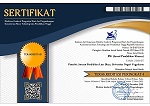Pengembangan sistem komunikasi augmentatif dan alternatif pada notasi dalam pembelajaran musik anak autis
Downloads
Downloads
Alant, E., Life, H., & Harty, M,(2005) "Comparison of the learnability and retention between Blissymbols and CyberGlyphs". International journal of language & communication disorders, 40(2), 151–169. DOI https://doi.org/10.1080/13682820400009980
Assistive ware "What is AAC". (2020) [Online]. Retrieved from https://www.assistiveware.com/learn-aac/what-is-,
Arthur-Kelly, dkk. (2009). Issues in the use of visual supports to promote communication in individuals with autism spectrum disorder. Disability and rehabilitation, 31(18), 1474–1486. https://doi.org/10.1080/09638280802590629
Beukelman DR, Mirenda P. (2005)"Augmentative and alternative communication: Supporting children and adults with complex communication need 3rd ed". Baltimore, MD: Paul H. Brookes Publishing Co.
Beukelman DR, Mirenda P (2013) ."Augmentative and alternative communication: Supporting children and adults with complex communication needs", 4th edition. Baltimore: Paul H. Brookes Publishing Co.
Bridgeschool. (2020). Communicative Competence. [Online]. Diakses dari http://communication,bridgeschool.org/intervemtion/aac-system-design-iding-principles/
Brownell M. D. (2002). "Musically adapted social stories to modify behaviors in students with autism": four case studies. Journal of music therapy, 39(2), 117–144. DOI https://doi.org/10.1093/jmt/39.2.117.
Charlop"Christy, M. H., Carpenter, M., Le, L., LeBlanc, L. A., & Kellet, K. (2002). Using the picture exchange communication system (PECS) with children with autism: Assessment of PECS acquisition, speech, social"communicative behavior, and problem behavior. Journal of applied behavior analysis, 35(3), 213-231.
Creswell. J.W, "Research design qualitative, quantitative, dan mixed method". California: Sage Publication. 2010
Dettmer, S., dkk. (2000). The Use of Visual Supports to Facilitate Transitions of Students with Autism. Focus on Autism and Other Developmental Disabilities, 15(3), 163–169. https://doi.org/10.1177/108835760001500307
Devlin, Meadows,(2020) "Integrating Alternative and Augmentative Communication into Music Therapy Clinical Practice: A Clinician's Perspective", Music Therapy Perspectives Journal, DOI: 10.1093/mtp/miaa010.
Dooley, P., Wilczenski, F. L., & Torem, C. (2001). Using an Activity Schedule to Smooth School Transitions. Journal of Positive Behavior Interventions, 3(1), 57–61. https://doi.org/10.1177/109830070100300108
Duffey, T., & Hodges, R. (2003). Establishing a helping relationship: Facilitating verbal and non-verbal communication. In Deese-Roberts (editor), Tutor training handbook (Rev ed.) Albuquerque, NM: College Reading and Learning AssociationM. Young, The Technical Writer's Handbook.Mill Valley, CA: University Science, (pp.65–75). 1989.
Ganz, J. B., & Flores, M. M. (2008). Effects of the use of visual strategies in play groups for children with autism spectrum disorders and their peers. Journal of autism and developmental disorders, 38(5), 926–940. https://doi.org/10.1007/s10803-007-0463-4
Hodges, R., & Duffey, T."Establishing a helping relationship: Self-discovery". in S. Deese-Roberts (editor). Tutor training handbook (Rev. ed.),. Albuquerque, NM: College Reading and Learning Association,( pp26–37), 2003.
Howlin P, Magiati I.(2017) Autism spectrum disorder: outcomes in adulthood. Curr Opin Psychiatry. ;30(2):69-76. doi:10.1097/YCO.0000000000000308
Kissinger,L., & Worley, D. W.(2008) "Using the harps as communication channe with Children with Autism". International Journal of Special Education, 23 (3) ,149-156.
Light, J., & McNaughton, D,(2013) "Putting people first: re-thinking the role of technology in augmentative and alternative communication intervention. Augmentative and alternative communication", (Baltimore, Md. : 1985), 29(4), 299–309. DOI https://doi.org/10.3109/07434618.2013.848935.
Logan, K., Lacono, T., & Trembath, D, (2016) "A systematic review of research into aided AAC to incrrease social-communication functionsin children with autism spectrum disorder". Augmentative and alternative sommunication journal, 33 (1), 51-64. DOI: https://doi.org/10.1080/07434618.2016.1267795.
Lue, M. S. (2001) "A survey of communication disorders for the classroom teacher". Boston: Allyn and Bacon.
Mc-Millan, J.H. dan Schumacher,(2010) S."Research in Education (Evidence Based Inquiry) 7th edition" New Jersey :
Mirenda, P. (2001). Autism, augmentative commu nication, and assistive technology: What do we really know?. Focus on Autism and Other Developmen tal Disabilities, 16 (1), 141"”145. DOI https://doi.org/10.1177/108835760101600302
Mirenda, P., & Erickson, K. A. (2000). Augmentative communication and literacy. Dalam A. M. Wetherby & B. M. Priznang (penyunting). Autism Spectrum Disorder: A transactional approach (hlm. 333-369). Baltimore: Paul H. Brookes Publishing Co.
Mizuko, M., & Reichle, J, (2005) "Transparency and recall of symbols among intellectually handicapped adults". J. Speech Hear. Disord. 1989, 54, 627–633. DOI https://doi.org/10.1044/jshd.5404.627.
Owen, Metz, Hass (2000), Introduction communication disorder: a life span perspective, Pearson.
Rowland, C., Fried-Oken, M., Steiner, S. A., Lollar, D., Phelps, R., Simeonsson, R. J., & Granlund, M (2012), "Developing the ICF-CY for AAC profile and code set for children who rely on AAC. Augmentative and alternative communication", 28(1), 21–32. DOI https://doi.org/10.3109/07434618.2012.654510.
Tawney J.W & Gast DL,(1984) "Single Subjet Research in Special Education", Colombus, OH: Charles E Merrill.
Tickle-Degnen, L., & Rosenthal, R. (1992). Nonverbal aspects of therapeutic rapport. Dalam R. S. Fieldman (Penyunting), Applications of nonverbal behavioral theories and research (pp. 143–164). Hillsdale, NJ: Lawrence Erlbaum Associates, Inc.
The National Academies of Sciences, Engineering, and Medicine. (2017) "The Promise of Assistive Technology to Enhance Activity and Work Participation". Washington DC: The National Academies Press,.
Tickle-Degnen, L., & Rosenthal, R. "Nonverbal aspects of therapeutic rapport". in R. S. Fieldman (editor), Applications of nonverbal behavioral theories and research Hillsdale, NJ: Lawrence Erlbaum Associates, Inc., (pp. 143–164). 1992.
Trembath, D., Vivanti, G., Iacono, T., & Dissanayake, C. (2015). Accurate or assumed: visual learning in children with ASD. Journal of autism and developmental disorders, 45(10), 3276–3287. https://doi.org/10.1007/s10803-015-2488-4
Valenti, M.et.al, (2010) "Intensive intervention for children and adolescents with autism in a community setting in Italy": a single-group longitudinal study. Child Adolescent Psychiatry Mental Health, 4 (23). DOI: https://doi.org/10.1186/1753-2000-4-23.
Warren, Z. et.al, (2011) "A systemic review of early intensive intervention for autism spectrum disorders.Pediatrics" , 127 (5), 1303-1311. DOI: https://doi.org/10.1542/peds.2011-0426.
Williams, M. B.,et.al, (2008) "Reach for the Stars": Five Principles for the Next 25 Years of AAC, Augmentative and Alternative Communication, 24:3, 194-206. DOI: https://doi.org/10.1080/08990220802387851.















